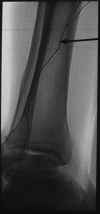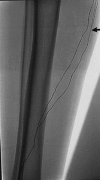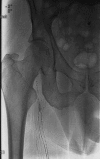Lymphangiography: a case study
- PMID: 21326747
- PMCID: PMC3036359
- DOI: 10.1055/s-2007-971180
Lymphangiography: a case study
Abstract
Lymphatic leak is a rare but well-described complication of a multitude of surgeries, whose sequela may potentially be life threatening. For cases refractory to conservative management, surgical therapy has been the mainstay of treatment. Although radiology has always played a contributory role in the diagnosis of lymphatic leaks with lymphoscintigraphy and lymphangiography, minimally invasive management of lymphatic leaks by interventional radiologists has only been described in the last decade. We present a case of percutaneous disruption of the cisterna chyli to treat a lymphatic leak of the thoracic duct.
Keywords: Lymphangiogram; cisterna chili; lymphatic leak.
Figures





References
-
- Barnacle A M, Kleidon T M. Lymphatic leak complicating central venous catheter insertion. Cardiovasc Intervent Radiol. 2005;28:839–840. - PubMed
-
- Porziella V, Cesario A, Margaritora S, Granone P. Role of pre-operative lymphangiogram and lympangioscintigraphy in the surgical management of spontaneous chylothorax. Eur J Cardiothorac Surg. 2006;30:813. - PubMed
-
- Merrigan B A, Winter D C, O'Sullivan G C. Chylothorax. Br J Surg. 1997;84:15–20. - PubMed
-
- Leibovitch I, Mor Y, Golomb J, Ramon J. The diagnosis and management of postoperative chylous ascites. J Urol. 2002;167:449–457. - PubMed
-
- Yamagami T, Masunami T, Kato T, et al. Spontaneous healing of chyle leakage after lymphangiography. Br J Radiol. 2005;78:854–857. - PubMed

